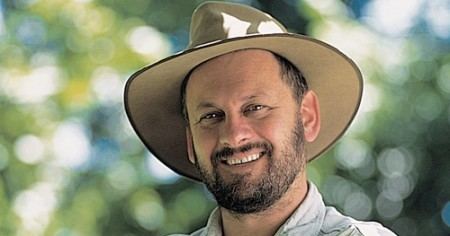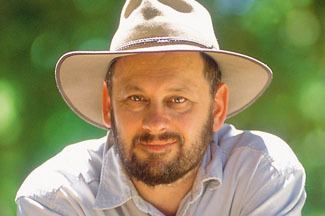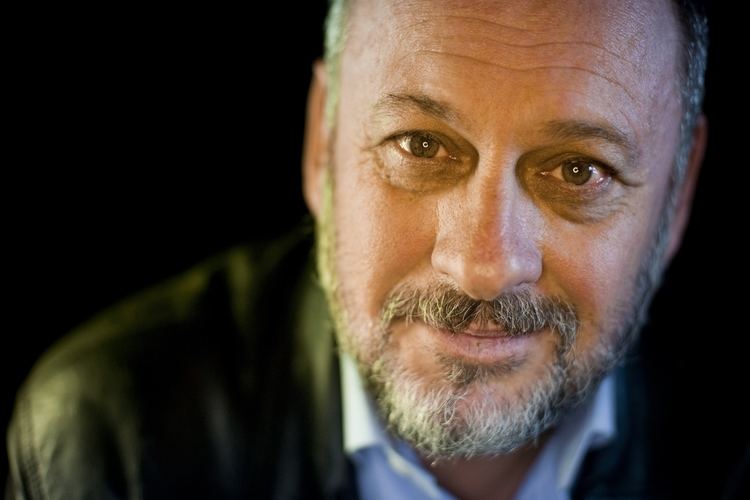Nationality Australian Role Palaeontologist Spouse Alexandra Szalay | Website www.timflannery.com.au Name Tim Flannery | |
 | ||
Full Name Timothy Fridtjof Flannery Known for Public speaking on the environment Awards Lannan Literary Award for Nonfiction Books The Weather Makers, The Future Eaters, Atmosphere of Hope: The Sear, Throwim Way Leg, A Gap in Nature | ||
Tim flannery climate change how to save the planet pt1 6
Timothy Fridtjof "Tim" Flannery (born 28 January 1956) is an Australian mammalogist, palaeontologist, environmentalist and global warming activist. He was the Chief Commissioner of the Climate Commission, a Federal Government body providing information on climate change to the Australian public. On 23 September 2013, Flannery announced that he would join other sacked commissioners to form the independent Climate Council, that would be funded by the community.
Contents
- Tim flannery climate change how to save the planet pt1 6
- Tim flannery climate change how to save the planet pt3 6
- Background
- Climate Commission and Climate Council
- Mammalogy
- Palaeontology
- Work on population and land use
- Climate change
- Species acclimatisation
- Carbon emissions
- Sustainable whaling
- Activism
- Humanitarian
- Awards
- Journalism
- Television series
- References

Tim Flannery is currently a Professorial Fellow at the Melbourne Sustainable Society Institute, University of Melbourne.

Professor Flannery was named Australian of the Year in 2007 and previously, until mid-2013, was a professor at Macquarie University and held the Panasonic Chair in Environmental Sustainability. He is also chairman of the Copenhagen Climate Council, an international climate change awareness group. His sometimes controversial views on shutting down conventional coal-fired power stations for electricity generation in the medium term are frequently cited in the media.

Tim flannery climate change how to save the planet pt3 6
Background

Flannery was raised in a Catholic family in the Melbourne suburb of Sandringham, close to Port Phillip Bay, where he learned to fish and scuba dive and became aware of marine pollution and its effects on living organisms. He completed a Bachelor of Arts degree in English at La Trobe University in 1977, and then took a change of direction to complete a Master of Science degree in Earth Science at Monash University in 1981. He then left Melbourne for Sydney, enjoying its subtropical climate and species diversity. In 1984, Flannery earned a doctorate at the University of New South Wales in Palaeontology for his work on the evolution of macropods (kangaroos).

Flannery has held various academic positions throughout his career. He spent many years in Adelaide, including a spell as Professor at the University of Adelaide, and 7 years as Director of the South Australian Museum. He was also Principal Research Scientist at the Australian Museum, and an adviser on environmental issues to the Australian Federal Parliament. In 1999 he held the year-long visiting Chair of Australian Studies at Harvard University. In 2002, Flannery was appointed as chair of South Australia's [Environmental Sustainability Board (South Australia)].
In 2007, Flannery became Professor in the Climate Risk Concentration of Research Excellence at Macquarie University. He left Macquarie University in mid-2013. Flannery is also a member of the Wentworth Group of Concerned Scientists, and a Governor of WWF-Australia. He has contributed to over 143 scientific papers.
Flannery is an advisor on climate change to outgoing South Australian Premier Mike Rann, and is a member of the Queensland Climate Change Council established by the Queensland Minister for Sustainability, Climate Change and Innovation Andrew McNamara. In February 2011 it was announced that Flannery had been appointed to head the Climate Change Commission established by Prime Minister Julia Gillard to explain climate change and the need for a carbon price to the public.
He lives in a house with environmental features at Coba Point on the Hawkesbury River, 40 km (25 mi) north of Sydney, accessible only by boat. Although situated 6 metres above high tide, critics have suggested it would be underwater if his predictions of sea level rise are borne out.
Climate Commission and Climate Council
On 10 February 2011, Flannery was appointed as the Chief Commissioner of the Climate Commission by the Australian Government. The Commission was a panel of leading scientists and business experts who's mandate was to provide an "independent and reliable" source of information for all Australians.
On 19 September 2013, Flannery was sacked from his position as head of the Climate Commission in a phone call from new Federal Environment Minister Greg Hunt. It was also announced that the Commission would be dismantled and its remit handled by the Department of Environment.
By 6 October 2013, Flannery and the other commissioners had launched a new body called the Climate Council. Flannery told ABC News that the organisation stated that it had the same goals as the former Climate Commission, to provide independent information on the science of climate change. Amanda McKenzie was appointed as CEO. Between 24 September and 6 October the new Climate Council had raised $1 million in funding from a public appeal, sufficient to keep the organisation operating for 12 months.
Mammalogy
Flannery's early research concerned the evolution of mammals in Australasia. As part of his doctoral studies, he described 29 new kangaroo species including 11 new genera and three new subfamilies. In the 1990s, Flannery published The Mammals Of New Guinea (Cornell Press) and Prehistoric Mammals Of Australia and New Guinea (Johns Hopkins Press), the most comprehensive reference works on the subjects. Through the 1990s, Flannery surveyed the mammals of Melanesia – discovering 21 new species – and took a leading role in conservation efforts in the region.
The specific name of the Greater Monkey-faced Bat (Pteralopex flanneryi), only described in 2005, honours Flannery.
Flannery's work prompted Sir David Attenborough to describe him as being "in the league of the all-time great explorers like Dr David Livingstone".
Palaeontology
In 1980, Flannery discovered dinosaur fossils on the southern coast of Victoria and in 1985 had a role in the ground-breaking discovery of Cretaceous mammal fossils in Australia. This latter find extended the Australian mammal fossil record back 80 million years. During the 1980s, Flannery described most of the known Pleistocene megafaunal species in New Guinea as well as the fossil record of the phalangerids, a family of possums.
Flannery was awarded humanist of the year in 2005 for his outstanding work in zoology.
Work on population and land use
In 1994, Flannery published The Future Eaters: an Ecological History of the Australasian Lands and People, and provides a sweeping glimpse of land, flora, fauna and people of the long past up to the present.
The synopsis of the work regards three waves of human migration in these regions. These waves of people Flannery describes as "future eaters". The first wave was the migration to Australia and New Guinea from south-east Asia approximately 40 000 – 60 000 years ago. The second was Polynesian migration to New Zealand and surrounding islands 800 – 3500 years ago. The third and final wave Flannery describes is European colonisation at the end of the eighteenth century.
Flannery describes the evolution of the first wave of future-eaters:
Sixty thousand or more years ago human technology was developing at what we would consider to be an imperceptible pace. Yet it was fast enough to give the first Australasians complete mastery over the ‘new lands’. Freed from the ecological constraints of their homeland and armed with weapons honed in the relentless arms race of Eurasia, the colonisers of the ‘new lands’ were poised to become the world’s first future eaters.While the book continues to be controversial in some of its hypotheses, it is a call to arms to preserve the Australasian natural heritage – and by extension global natural heritage.
Perhaps his most controversial hypothesis regards early Australian Aboriginal history; Flannery paints an intriguing picture. Based on new sediment core studies, the continent up until 100,000 years ago had much greater expanses of rainforest than after Aboriginal arrival. He poses the "possibility" did Aborigines through firestick farming alter the ecology of Australian flora and fauna? Flannery links other circumstantial evidence to the puzzle predisposing his hypothesis, such as the continent’s long suffering poor soils, historical extinction events of other continents and tens of thousands of years of fire adaptation.
Flannery also argues the hypothesis that at current population growth rate levels, Australasia is living beyond its population carrying capacity, to the extent that its biological stability has been damaged. European colonisation of Australia and New Caledonia brought its own artefacts and ways suitable in the ‘old world’, and yet struggle to adapt its "culture to biological reality". This reality is evident in Australia, where unpredictable climate combined with a lack of natural life giving resources have created a flora and fauna that have adapted over millennia to be extraordinarily efficient in the consumption of energy.
The Future Eaters enjoyed strong sales and critical acclaim. Redmond O'Hanlon, a Times Literary Supplement correspondent said that "Flannery tells his beautiful story in plain language, science popularising at its antipodean best". Fellow activist David Suzuki praised Flannery's "powerful insight into our current destructive path". Some experts disagreed with Flannery's thesis, however, concerned that his broad-based approach, ranging across multiple disciplines, ignored counter-evidence and was overly simplistic.
The Future Eaters was made into a documentary series for ABC Television and was republished in late 2013
Climate change
In May 2004 Flannery said, "I think there is a fair chance Perth will be the 21st century's first ghost metropolis". He reiterated that prediction in 2007. Fortunately Perth heeded his warning and started building desalinisation plants and today more that half the city's water comes from the sea. In April 2005, he said, "water is going to be in short supply across the eastern states". In June 2005 Flannery said, "the ongoing drought could leave Sydney’s dams dry in just two years".news|url=http://www.abc.net.au/news/2005-06-11/climate-change-will-prolong-drought-conditions/1590294 |title=Climate change 'will prolong' droug
In September 2005 Flannery said, "There are hot rocks in South Australia that potentially have enough embedded energy in them to run Australia's economy for the best part of a century". Also for the Cooper Basin, he proposed the establishment of a fully sustainable city where, "hundreds of thousands of people would live", utilising these geothermal energy reserves. He named the city, "Geothermia". Subsequently, in 2007, an exploration company was established. The company expected to raise at least $11.5m on the Australian Stock Exchange. Flannery took up shares in the company. In 2010, the Federal Government provided the company with another $90m for the development work. In August 2016, the geothermal energy project closed as it was not financially viable.
In October 2006 Flannery said, there may be, "no Arctic icecap in the next five to 15 years [...] with the ocean [possibly to eventually] rise by six metres". He also quoted, "arguably the world authority on climate change" who said, "we have just a decade to avert a 25-metre rise of the sea". In February 2007, as he explained how increased soil evaporation impacts on runoff, he said "even the [existing amount of] rain that falls isn’t actually going to fill our dams and our river systems" and in June 2007, as the Millennium drought raged, he said that, "Adelaide, Sydney and Brisbane, water supplies are so low they need desalinated water urgently, possibly in as little as 18 months".
Species acclimatisation
In The Future Eaters, Flannery was critical of the European settlers introducing non-native wild animals into Australia's ecosystem. At the same time, he suggested that if one wanted to reproduce, in some parts of Australia, the ecosystems that existed there ca. 60,000 years ago (before the arrival of the humans on the continent), it may be necessary to introduce into Australia, in a thoughtful and careful way, some non-native species that would be the closest substitutes to the continent's lost megafauna. In particular, the Komodo dragon can be brought into Australia as a replacement for its extinct relative, Megalania, "the largest goanna of all time". The Tasmanian devil could also be allowed to re-settle the mainland Australia from its Tasmanian refuge area.
In The Eternal Frontier, Flannery made a proposal for what later became nicknamed "Pleistocene rewilding": restoring the ecosystems that existed in North America before the arrival of the Clovis people and the concomitant disappearance of the North American Pleistocene megafauna ca. 13,000. He wonders if, in addition to the wolves that have been already re-introduced to Yellowstone National Park, ambush predators, such as jaguars and lions should be reintroduced there as well, in order to bring the number of elks under control. Furthermore, the closest extant relatives of the species that became extinct around the Clovis period could be introduced to North America's nature reserves as well. In particular, the Indian and African elephants could substitute, respectively, for the mammoth and the mastodon; the Chacoan Peccary, for its extinct cousin the flat-headed Peccary (Platygonus compressus). Llamas and panthers, which still survive outside of the USA, should too be brought back to that country.
Carbon emissions
In The Weather Makers: The History & Future Impact of Climate Change, Flannery outlined the science behind anthropogenic climate change. "With great scientific advances being made every month, this book is necessarily incomplete," Flannery writes, but "That should not, however, be used as an excuse for inaction. We know enough to act wisely."
Concepts outlined in the book include:
The book won international acclaim. Bill Bryson concluded that "It would be hard to imagine a better or more important book." The Weather Makers was honoured in 2006 as 'Book of the Year' at the New South Wales Premier's Literary Awards.
Flannery's work in raising the profile of environmental issues was key to his being named Australian of the Year in 2007. Awarding the prize, former Prime Minister John Howard said that the scientist "has encouraged Australians into new ways of thinking about our environmental history and future ecological challenges."
That said, Howard – along with many others – remains unconvinced as to Flannery's proposed solutions. Flannery joined calls for the cessation/reduction of conventional coal-fired power generation in Australia in the medium term, the source of most of the nation's electricity. Flannery claims that conventional coal burning will lose its social license to operate, as has asbestos.
In response to the introduction of proposed clean coal technology, Flannery has stated: "Globally there has got to be some areas where clean coal will work out, so I think there will always be a coal export industry [for Australia] ... Locally in Australia because of particular geological issues and because of the competition from cleaner and cheaper energy alternatives, I'm not 100 per cent sure clean coal is going to work out for our domestic market."
In 2006 Flannery was in support of nuclear power as a possible solution for reducing Australia's carbon emissions, however in 2007 changed his position against it. In May 2007 he told a business gathering in Sydney that while nuclear energy does have a role elsewhere in the world, Australia's abundance of renewable resources rule out the need for nuclear power in the near term. He does however feel that Australia should and will have to supply its uranium to those other countries that do not have access to renewables like Australia does.
In May 2008 Flannery created controversy by suggesting that sulphur could be dispersed into the atmosphere to help block the sun leading to global dimming, in order to counteract the effects of global warming.
Sustainable whaling
When, in the concluding chapters of The Future Eaters (1994), Flannery discusses how to "utilise our few renewable resources in the least destructive way", he remarks that
A far better situation for conservation in Australia would result from a policy which allows exploitation of all of our biotic heritage, provided that it all be done in a sustainable manner. ... [I]f it is possible to harvest for example, 10 mountain pygmy-possums (Burramys parvus) or 10 southern right whales (Balaena glacialis) per year, why should we not do it? ... Is it more moral to kill and consume a whale, without cost to the environment, than to live as a vegetarian in Australia, destroying seven kilograms of irreplaceable soil, ... for each kilogram of bread we consume?In late 2007, Flannery suggested that the Japanese whaling involving the relatively common Minke Whale may be sustainable:
In terms of sustainability, you can't be sure that the Japanese whaling is entirely unsustainable... It's hard to imagine that the whaling would lead to a new decline in populationThis raised concerns among some environmental groups such as Greenpeace, fearing it could add fuel to the Japanese wish of continuing its annual cull. In contrast to his stance on the Minke Whale quota, Flannery has expressed relief over the dumping of the quota of the rarer Humpback Whale, and further was worried how whales were slaughtered, wishing them to be "killed as humanely as possible". Flannery suggested that krill and other small crustaceans, the primary food source for many large whales and an essential part of the marine food chain, were of greater concern than the Japanese whaling.
Activism
Flannery has achieved prominence through his environmental activism. His advocacy on two issues in particular, population levels and carbon emissions, culminated in being named Australian of the Year (2007) at a time when environmental issues were becoming prominent in Australian public debate.
He is a member of the World Future Council.
Humanitarian
In 2009, Flannery joined the project "Soldiers of Peace", a move against all wars and for a global peace.
